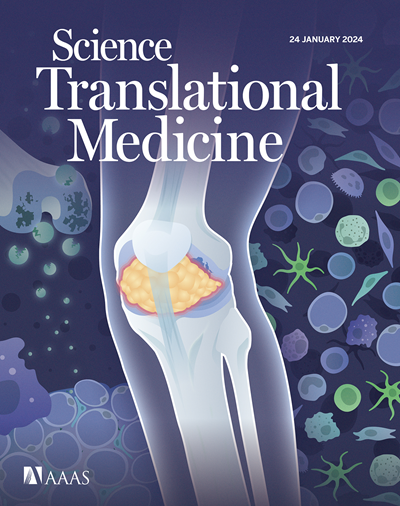肝脏靶向过敏原免疫治疗快速、安全地诱导抗原特异性耐受治疗小鼠过敏性气道疾病
IF 15.8
1区 医学
Q1 CELL BIOLOGY
Science Translational Medicine
Pub Date : 2025-04-16
引用次数: 0
摘要
目前的哮喘治疗控制疾病症状,但未能解决过敏性疾病的根本原因。过敏原免疫疗法通过反复引入天然过敏原,建立过敏原特异性耐受性,有望实现持久的疾病控制;然而,其疗效可能受到长期干预、给药后反应和患者依从性差的限制。在这里,我们开发了一种快速、安全、有效的肝脏靶向过敏原免疫疗法(LIT),以提供长期的疾病控制。我们从天然呼吸道过敏原中开发出LIT耐受性原,仅通过两种干预就能诱导体内抗原特异性调节性T (Treg)细胞。天然过敏原的合成甘露糖基化阻止了抗体介导的识别和随后危及生命的过敏反应。蛋白质工程防止了由于天然呼吸道过敏原的蛋白水解活性而发生的致敏事件,这限制了过敏原免疫治疗的有效性。在变应性哮喘的临床前模型中,LIT改善了临床、病理和血清学特征,其保护作用依赖于抗原特异性Treg细胞。在致敏小鼠中,LIT在没有额外干预的情况下提供了长达一年的过敏性哮喘症状控制。最后,LIT诱导针对Der p1的抗原特异性Treg细胞,Der p1是临床相关屋尘螨(HDM)呼吸道过敏原的主要蛋白。在已建立HDM过敏的小鼠中,LIT耐受性良好,并提供过敏症状缓解。总之,我们的数据提供了一个概念证明,合成甘露糖基化耐受性原的LIT提供了一种快速、安全、有效的过敏原免疫治疗方法,并有望持久控制过敏性哮喘。本文章由计算机程序翻译,如有差异,请以英文原文为准。
Liver-targeted allergen immunotherapy rapidly and safely induces antigen-specific tolerance to treat allergic airway disease in mice
Current asthma treatments manage disease symptoms but fail to address the underlying cause of allergic disease. Allergen immunotherapy holds the promise for durable disease control by establishing allergen-specific tolerance through repeated introduction of native allergens; however, its efficacy can be limited by long interventions, reactions upon administration, and poor patient compliance. Here, we developed a rapid, safe, and effective liver-targeted allergen immunotherapy (LIT) to provide long-term disease control. We developed LIT tolerogens from native respiratory allergens, which induced antigen-specific regulatory T (Treg) cells in vivo with only two interventions. Synthetic mannosylation of native allergens prevented antibody-mediated recognition and subsequent life-threatening anaphylaxis upon administration. Protein engineering prevented sensitization events that occurred because of the proteolytic activity of native respiratory allergens, which limit the effectiveness of allergen immunotherapy. In preclinical models of allergic asthma, LIT ameliorated clinical, pathological, and serological features, and protection was dependent on antigen-specific Treg cells. In sensitized mice, LIT provided a year-long control of allergic asthma symptoms in the absence of additional intervention. Last, LIT induced antigen-specific Treg cells against Der p 1, a major protein in the clinically relevant house dust mite (HDM) respiratory allergen. In mice with established HDM allergy, LIT was well tolerated and provided allergic symptom relief. Together, our data provide a proof of concept that LIT with synthetically mannosylated tolerogens provides a rapid, safe, and effective approach to allergen immunotherapy and holds promise for durable control of allergic asthma.
求助全文
通过发布文献求助,成功后即可免费获取论文全文。
去求助
来源期刊

Science Translational Medicine
CELL BIOLOGY-MEDICINE, RESEARCH & EXPERIMENTAL
CiteScore
26.70
自引率
1.20%
发文量
309
审稿时长
1.7 months
期刊介绍:
Science Translational Medicine is an online journal that focuses on publishing research at the intersection of science, engineering, and medicine. The goal of the journal is to promote human health by providing a platform for researchers from various disciplines to communicate their latest advancements in biomedical, translational, and clinical research.
The journal aims to address the slow translation of scientific knowledge into effective treatments and health measures. It publishes articles that fill the knowledge gaps between preclinical research and medical applications, with a focus on accelerating the translation of knowledge into new ways of preventing, diagnosing, and treating human diseases.
The scope of Science Translational Medicine includes various areas such as cardiovascular disease, immunology/vaccines, metabolism/diabetes/obesity, neuroscience/neurology/psychiatry, cancer, infectious diseases, policy, behavior, bioengineering, chemical genomics/drug discovery, imaging, applied physical sciences, medical nanotechnology, drug delivery, biomarkers, gene therapy/regenerative medicine, toxicology and pharmacokinetics, data mining, cell culture, animal and human studies, medical informatics, and other interdisciplinary approaches to medicine.
The target audience of the journal includes researchers and management in academia, government, and the biotechnology and pharmaceutical industries. It is also relevant to physician scientists, regulators, policy makers, investors, business developers, and funding agencies.
 求助内容:
求助内容: 应助结果提醒方式:
应助结果提醒方式:


